In January, 2009, I conducted a detailed historical analysis of overbought conditions in the stock market (see “Using the Percentage of Stocks Trading Above Their 40DMAs (T2108) to Identify Overbought Conditions on the S&P 500“). At the time, the S&P 500 was at historically extreme overbought levels just two months ahead of its sickening drop to historic 13 1/2 year lows. Since that time, the S&P 500 has experienced an amazing 27 additional overbought periods.
The median duration of an overbought period fell from 4.5 to 4.0 days. The average increased from 8.9 to 9.2 days thanks to four historically long overbought periods, particularly a 52-day stretch in 2009 and a 47-day stretch in 2010.
Currently, the index has been overbought for 10 days and seems well on its way to another historic overbought period. 71% of all overbought periods have ended before 10 days. This seems like a great time to finally update the overbought analysis.
To flag overbought periods, I use an indicator based on the percentage of stocks trading above their 40-day moving averages (DMAs), known as “T2108” to users of Worden Telechart or FreeStockCharts.com. The stock market is overbought when T2108 equals at least 70% (this is a minor refinement from the previous analysis which defined overbought as T2108 > 70%). Oversold conditions hold when T2108 equals 20% or lower. (For more on T2108 oversold conditions see my T2108 Resource Page.)
Strategically, when T2108 drops to 20% or lower, traders should not initiate new bearish positions. As the indicator goes lower, traders should close bearish positions and start accumulating new bullish positions. When T2108 increases to 70% or higher, traders should not initiate new bullish positions. As the indicator goes higher, traders should close bullish positions and start accumulating new bearish positions. The fundamental premise is that the market does not rest long at these technical extremes and acting contrary to the existing market momentum is the better risk/reward proposition for short-term trades.
T2108 is calculated using all stocks trading on the NYSE. Historical data go back to September 17, 1986. Worden’s Telechart does not provide a similar indicator for the S&P 500. Note that stockcharts.com provides $SPXA50R for measuring the percentage of stocks in the S&P 500 trading above their respective 50DMAs. Stockcharts.com also provides $NYA50R for measuring the percentage of stocks in the NYSE trading above their respective 50DMAs. It would clearly be ideal to use an indicator based on the S&P 500, but to the extent the S&P 500 is a broad enough sample of the entire market, this analysis should be accurate enough for the purpose at hand.
So how do we know that T2108 trading above 70% represents an overbought condition? T2108 typically spends less time above the threshold than it spends returning to the threshold. The chart below shows that the S&P 500 typically spends very few days trading above 70%: the majority of the time it is under 5 days, and the vast majority of the time (71%) it is less than 10 days. As stated earlier, the average duration is 9.2 days, and the median is 4.0 days.
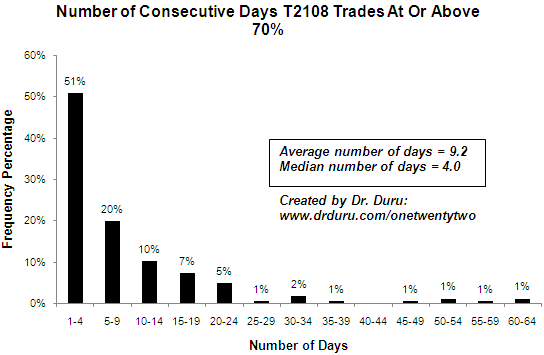
A return to the 70% threshold takes 1 to 4 days only 45% of the time. The vast majority of the time (77%), it takes up to 19 days for a return to 70%. The average is 30.9 days, and the median is 7.0 days.
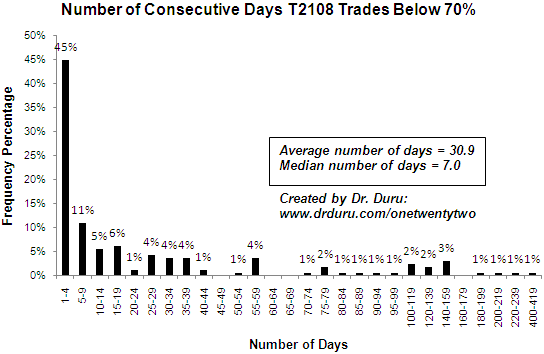
Think of this as the rule of gravity for stocks: what goes up, must eventually come down…or at least take a rest for a while. The longer the market goes up without resting, the more likely it is to rest.
So why not use 80%, 90%, or even 60% as a threshold? Well, we should expect this kind of indicator to trigger the most at its 50% mark. That is the least useful point of differentiation. As the threshold moves higher, the indicator should get more effective. The chart below shows that T2108 trips the 60% threshold the same amount of time as it trips the 50% threshold. T2108 becomes a much better filter at 70% and a big drop in frequency occurs at 80%. By 90%, T2108 is exploring the most extreme corners of stock market history and becomes useless as a primary filter. Given this breakdown, I think a reasonable rule of thumb for overbought is as follows: 70% represents the yellow flag (no new bullish positions, get ready to close existing bullish positions, initiate some bearish positions); 80% represents the red flag (close all existing bullish positions, accumulate bearish positions); 90% represents the bright red flag.
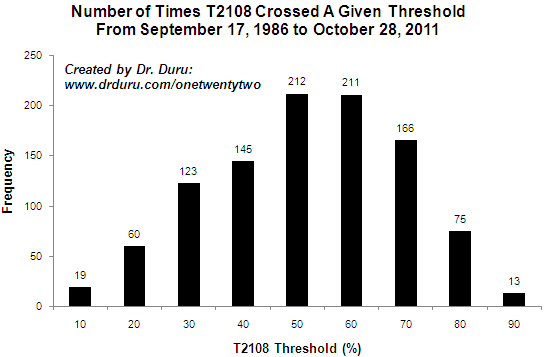
Traders might try to take advantage of this rule of thumb by selling as soon as T2108 dips back below 70%. On average, or typically, this method produces nearly the same result as selling as soon as T2108 crosses above 70%. The average and median returns are essentially zero. After my first overbought T2108 analysis, I was surprised that both measures were not worse. I remain surprised.

The implication is that closing out bullish positions at the beginning or end of an overbought period make little difference to overall performance. However, it will complicate strategies for playing the downside potential of an overbought period.
Clearly, a trader could improve results by finding a point within the overbought period to close bullish positions and to initiate bearish positions. A trader could try to wait 4 days, the median duration of an overbought period. The chart below shows the maximum return if a trader’s timing is absolutely perfect. Notice that the median return makes a marginal improvement from the first strategy. The average return makes only a slightly better improvement.

The longer T2108 remains above 70%, the higher the return. This relationship is not surprising. The high correlation exists for selling once T2108 dips back below 70%, and the correlation is even higher for the maximum return. These correlations are the same over the entire historical period and from 2003-2008, the approximate period of the previous bull market. Of course, a trader can never know in advance how long T2108 will stay overbought.
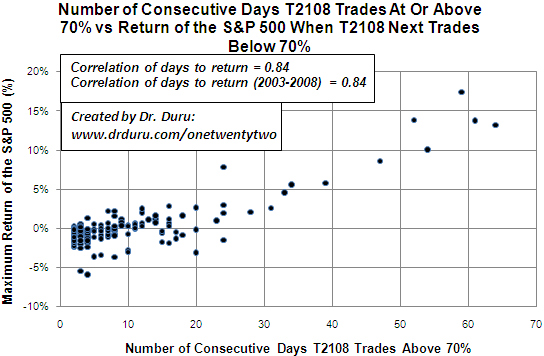
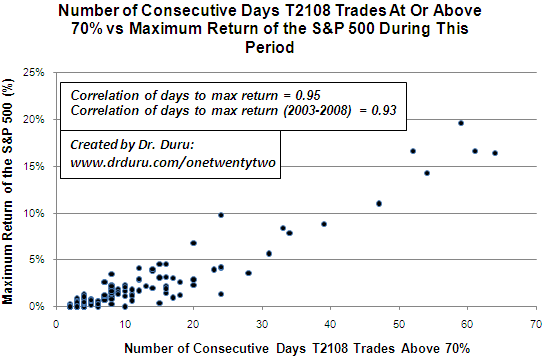
Note how 20-30 days represents a type of tipping point. If an overbought period gets past that point, we can expect the S&P 500’s performance to improve rather rapidly. This observation can help in creating stops for bearish positions and gauging the potential reward for maintaining any remaining bullish positions.
The T2108 outliers deliver substantial gains. Interestingly, waiting until T2108 dips back below 70% achieves the majority of the gains from these outliers. This behavior implies that once T2108 extends past the tipping point, a trader would do well to just keep holding bullish positions until the overbought period ends. The table below compares the return on the S&P 500 when a trader sells the first day the overbought period ends versus the maximum achievable return of the period. Remember, it is not realistic to expect to extract the maximum gain.
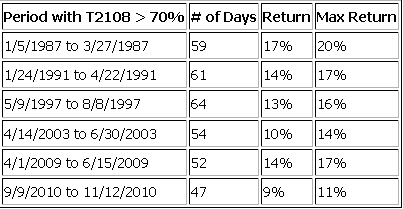
In summary, T2108 is a good overbought indicator for the S&P500. Traders holding bullish positions once T2108 signals overbought conditions can wait to close out these positions until T2108 dips back below the 70% threshold. Over time, this strategy preserves capital, reduces churn, preserves gains from the previous rally, and will capture the majority of the maximum returns when the S&P 500 remains overbought for extremely long stretches of time. Traders who prefer to play the downside potential of overbought conditions should sell bullish positions once T2108 signals overbought conditions and begin accumulating bearish positions. The maximum returns shown above then become the maximum expected downdraft. The bearish trader should manage risk accordingly and plan to ADD to bearish positions the longer the overbought period lasts with a potential stop once the overbought period gets to 20-30 days in duration.
Be careful out there!
Full disclosure: long SDS

I noticed that your full disclosure no longer lists a long put position on VXX. Have you given up on the prospect of a decline in volatility in the near-to-intermediate term?
Regards,
Jeff J.
I disclose relative to stocks mentioned in the given article. I didn’t talk about volatility in this piece. However, I am definitely still long those VXX puts, but it seems I will run out of time this cycle to get my profit back. I will be rolling over into a new set of puts either right before these expire or shortly after.